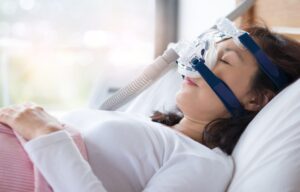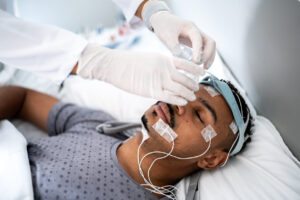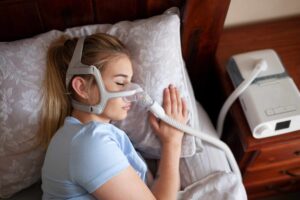8 Step-by-step guide on how to set up and use the CPAP machine

Hello there! Have you been instructed to use a CPAP machine to correct or treat obstructive sleep apnea or any other sleep order? In other words, are you diagnosed with sleep apnea? Oh! Do you know the uses of a CPAP machine? There’s no cause for alarm. We will give you full details on what you need to know about CPAP mask setup.
Please note that this article is not replacing the steps you need to take. In other words, you need to consult a sleep doctor if you see some signs of sleep apnea. Then, what symptoms may likely show that you need to use a CPAP machine Australia?
Snoring, headache, and irritation are common signs that one may likely use a CPAP machine. However, do not forget that it is expedient to visit your doctor to examine you. Why? There are other means of treating obstructive sleep apnea.
In fact, one can overcome OSA via surgery and some other means. But if your sleep specialist instructed you to buy a CPAP machine, there are step-by-step steps to use it and set it up. And that is what this article is all about.
It would be nice to create a piece of background knowledge. Hence, in this write-up, we will discuss the meaning of a CPAP machine. Then, we will proceed to the step-by-step guide on how to set up and use a CPAP machine.
What is a CPAP machine?
A continuous positive airway pressure (CPAP) machine is the most frequently prescribed device to treat sleep apnea problems.
Breathing pauses or interruptions are brought on by obstructive sleep apnea (OSA), frequently due to a temporary obstruction or collapse of the throat or airways. While you sleep, a CPAP machine continuously blows compressed air into your mouth and nose.
This helps you breathe correctly by keeping your airways open. In other words, continuous positive airway pressure (CPAP) therapy is a frequent treatment for obstructive sleep apnea.

To help you breathe while you sleep, a CPAP machine uses a hose linked to a mask or nosepiece to deliver consistent and stable air pressure.
A leaky mask, difficulty settling asleep, a stuffy nose, and a dry mouth are typical CPAP side effects. Furthermore, Continuous positive airway pressure, or CPAP, is a device that uses light air pressure to maintain your airways open while you sleep.
To address respiratory abnormalities connected to sleep, such as sleep apnea, your doctor may recommend CPAP. Underdeveloped lungs in premature newborns may also be treated with CPAP.
You may be curious to know if CPAP machines are suitable for sleep. Sleep apnea frequently causes drowsiness and afternoon weariness. By removing breathing pauses while you sleep, the CPAP device can help you return to your regular sleeping habits and extend your time in bed.
Hence, you’ll feel more rested when you wake up, and your energy levels will increase throughout the day.
Also, the CPAP device has a nasal pillow mask. The nasal mask will protect your skin. Most CPAP masks are made of silicone. That is why it is essential to get the right CPAP machine. It is good to buy a new CPAP machine.
Furthermore, you must also get CPAP that aligns with your sleep position. Honestly, CPAP treatment is the best way to treat OSA. Some CPAP masks have two pressure settings. But your doctor might prescribe one pressure settings to you.
There are other alternatives. Doctors can prescribe APAP machines, Bilevel machines, and BiPAP machines.
How to use and setup CPAP masks
1. Put the CPAP machine in a good place
Deciding where to place the CPAP is the first step. A suitable location for your gadget has the following qualities:
- Provides the CPAP base with reliable support.
- Permits the hose to reach the bed’s head.
- Enough distance from an outlet for you to plug the device in
- Enables easy operation of the device, including the ability to access the filter chamber and add water to the humidifier.
The ideal location for most individuals is a nightstand or small table close to their bed. This part is essential to get a good night’s sleep.

2. Ensure you check the filter
The CPAP machine has a removable filter; however, your specific equipment will determine the kind of filter it has.
The filter usually fits tightly into a small compartment. Specific information on the filter in your CPAP machine should be provided in written instructions or instructions from your sleep technician.
3. Connect the CPAP Machine’s Hose
The hose has a unique hookup on the machine. As a result, the hose should connect and remain in position without requiring a lot of force or effort.
All CPAP hoses are compatible with all CPAP masks and include a 22mm connector cuff. Most CPAP machines have connection ports that can accommodate standard 19mm tubing. Numerous more recent devices can accommodate 15mm slim or thin tubing.
4. Attach the mask’s hose
CPAP tubing that is longer gives you more mobility if you are an active sleeper. However, increasing length has drawbacks if you’re also utilizing a humidifier and a heated hose. The air may lose heat and humidity as it moves from your machine to your mask due to the longer distance.
Hence, the CPAP mask is connected to the opposite end of the hose, which should make a secure connection by clicking occasionally.

5. Ensure you set the humidifier
A humidifier is frequently added to CPAP machines, so the air is more pliable and less likely to dry up your mouth and throat throughout the night. If your CPAP includes a humidifier, use only distilled water.
The mineral buildup and impurity problems that can result from utilizing tap water are avoided by using distilled water. The “MAX” fill line in the humidifier reservoir must be visible. Avoid going beyond that limit to avoid having water enter the hose.
6. Plug in the Continuous Positive Air Pressure
The next thing is to ensure the power cord is appropriately attached to the continuous positive air pressure. Then, you need to plug the device into an electric outlet.
7. Adjust the CPAP mask and put it on
A CPAP machine can be used with a variety of masks. Full-face masks cover your mouth and nose.
Other masks cover the nose or only cover the bottom. Your breathing pattern, the amount of pressure you require, and your sleeping posture will all be taken into consideration by your doctor or sleep specialist when making a mask recommendation.
No matter what mask you use, it will be secured in place by one or more straps that go over your head’s crown and back.
8. Turn on the device and find a comfortable sleeping position
The last step you need to take is to turn on the CPAP machine and ensure you get a comfortable sleeping position.
On a final note
Dear reader, do you know you now have all it takes to make things work? Of course, the above-listed information is enough to turn things around. In this write-up, we explained the meaning of the CPAP machine.
Then, we discussed the step-by-step guide on setting up and using a CPAP mask. Hence, please visit the clinic and talk to your doctor. Thanks for reading.
Never Miss: The Side Effects of CPAP Masks and the Solutions



